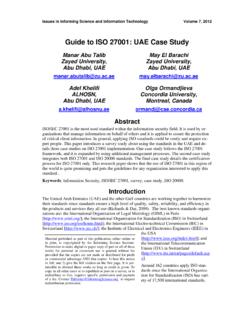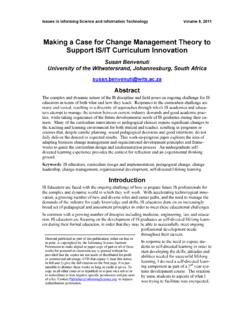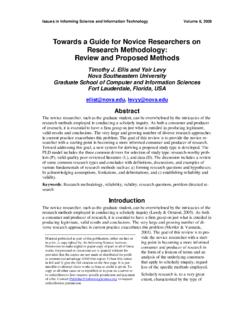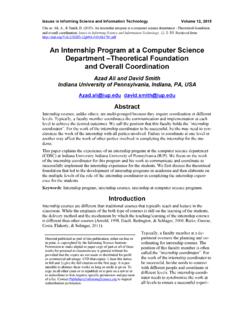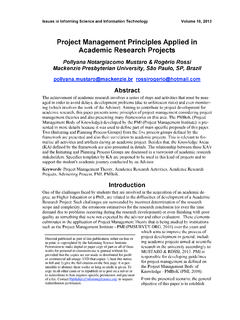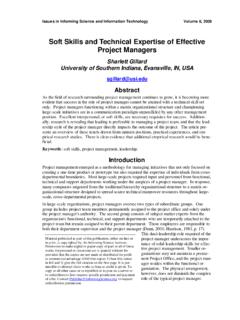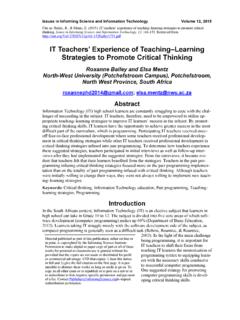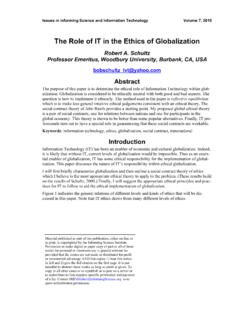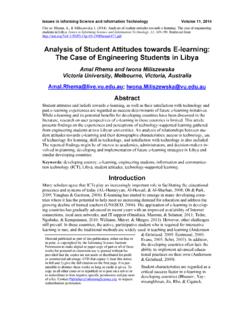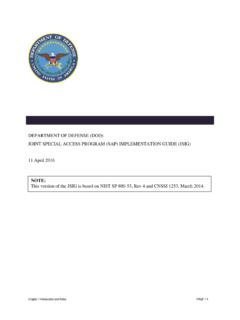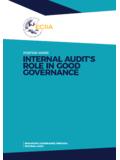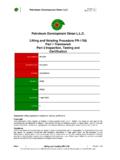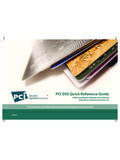Transcription of The Adoption of Single Sign-On and Multifactor ...
1 Issues in Informing Science and Information Technology Volume 7, 2010 The Adoption of Single Sign-On and Multifactor authentication in Organisations A Critical Evaluation Using TOE Framework Marise-Marie D Costa-Alphonso University of Southern Queensland, Melbourne, Victoria, Australia Lane School of Information Systems, Faculty of Business, University of Southern Queensland, Toowoomba, Queensland, Australia Abstract The proliferation of user credentials for system access coupled with the resulting rising security threats have led to the development of Single Sign-On (SSO) access control and multi-factor au-thentication (MFA) technologies. This paper provides an overview of these authentication mechanisms, highlighting the current state in the marketplace and describing the key enabling technologies.
2 We conducted a qualitative analysis to identify the key factors facilitating and in-hibiting the Adoption of SSO and MFA by organisations using the Technology- organisation -Environment (TOE) framework. The resulting analysis indicates a range of technologies, proto-cols and configurations that can be employed depending on the type of authentication and level of security required. The findings suggest that a number of technology, organisation and environ-ment factors both positively and negatively affect organisational Adoption of SSO and MFA. There are a number of key benefits gained from adopting SSO and MFA such as increased corpo-rate security and reduced organisational costs of managing access control. There are also a num-ber of key challenges to be overcome by organisations adopting SSO and MFA.
3 These include the ability to accommodate the complexity of multiple heterogeneous systems and to be resilient to new information security threats thereby allowing a SSO and MFA solution to deliver improved and secure access control to information systems both within and across organisations. Keywords: Single Sign-On (SSO), Multifactor authentication (MFA), Technology- organisation -Environment framework (TOE), authentication technologies, Organisational Adoption of SSO and MFA Introduction In many organisations, system users are required to remember a number of dif-ferent usernames and passwords on a daily basis to access core systems. In dealing with the complexity of multiple user names and passwords organisations often have to make a compromise be-tween user convenience and security. Material published as part of this publication, either on-line or in print, is copyrighted by the Informing Science Institute.
4 Permission to make digital or paper copy of part or all of these works for personal or classroom use is granted without fee provided that the copies are not made or distributed for profit or commercial advantage AND that copies 1) bear this notice in full and 2) give the full citation on the first page. It is per-missible to abstract these works so long as credit is given. To copy in all other cases or to republish or to post on a server or to redistribute to lists requires specific permission and payment of a fee. Contact to request redistribution permission. Single Sign-On and Multifactor authentication in Organisations 162 Single Sign-On (SSO) access control and Multifactor authentication (MFA) are security mecha-nisms that aim to shift the balance of this compromise by making access to core business systems both more convenient for users and more secure.
5 In this paper a critical review of these two re-lated security authentication mechanics provides insights into the current technologies and proto-cols, which enable SSO and MFA. In addition the organisational and environmental aspects that influence implementation of SSO and MFA are presented. Challenges and benefits that organisa-tions need to consider when adopting SSO and MFA are also highlighted to offer views as to whether the security-user convenience compromise does indeed shift. Then we present a pre-liminary analysis of the key factors impacting on SSO and MFA implementations in organisa-tions guided by the Technology- organisation -Environment (TOE) framework. This analysis is informed by the opinions of industry practitioners working in this domain who have discussed these topics on blogs and online discussion forums.
6 Finally we present our conclusions and impli-cations regarding this research and provide suggestions for future work in this area. Overview of Topic and Current State of Play Background Users increasingly access a myriad of systems applications on a daily basis via devices such as desktop computers, laptops, mobile phones and PDAs from a variety of locations. For each of these systems applications, users may have separate identities for authentication as shown in Fig-ure 1. The explosion of system applications such as email, customer-relationship management and financial systems (Osterman Research Inc, 2009) coupled with multi-device access to these systems requires concrete security measures to manage data integrity, user privacy and network security. In addition, user convenience is an important consideration that security solutions should address to prevent users from having to re-authenticate themselves repeatedly (FinallySecure, 2009).
7 Currently the average user accesses around 12 different password-protected systems daily at work (Osterman Research Inc, 2009). With so many passwords to remember users either write them down ( The value of enterprise Single Sign-On , 2006), use the same password to access multiple Figure 1: Multi-system, multi-device, multi-identity proliferation (Source: Shaw, 2008, p. 1 used with permission) D Costa-Alphonso & Lane 163 systems (Osterman Research Inc, 2009) or make them easy to remember and hence easy to crack via dictionary attacks or social engineering techniques (Liou, 2007; Panko, 2009) thereby de-creasing system security. This factor together with others such as increased help desk costs and the need for shared workstation support are the driving forces behind Adoption of Single Sign-On systems (Kreizman, 2008) and multi-factor authentication technologies.
8 Single Sign-On Single Sign-On bears the promise of addressing the issues of user convenience, reduced costs and increased security (Robbins & Hamilton, ; , 2008). Single Sign-On (SSO) refers to a user entering just one set of credentials for authentication and authorization and there-after being able to access multiple applications securely and seamlessly. These applications may reside on multiple domains and the SSO system handles the user s credentials across these do-mains (The Open Group, 2009). SSO did not initially work as anticipated because the technologies performed poorly, but this has now changed ( The value of enterprise Single Sign-On , 2006). SSO is projected to increase in popularity due to the increasing business interactions that enterprises have with employees, busi-ness partners and customers (Dubin, 2008b) via their computer networks and systems applica-tions.
9 Maximising user convenience for system access has the equal benefit of reducing organisa-tional IT costs since SSO systems streamline the authentication and authorization process (Schneier, 2005a; , 2008). Organisations are also embracing SSO solutions as part of their Identity and Access Management (IAM) suites (Dubin, 2008b; The Strategic Counsel, 2007) - requirements in many industries in order to meet mandated compliance from regulations such as Sarbanes-Oxley (SOX) and the Health Insurance Portability and Accountability Act (HIPAA) in the US (Dubin, 2008b) - requir-ing sophisticated access control functions. These include user provisioning and user auditing, for example, the time users spend on systems, users login times and so on (Dubin, 2008b; Osterman Research Inc, 2009). In the US, 36% of healthcare organisations are currently using SSO (Tiaz-kun, 2009).
10 In Australia, organisations may employ IAM suites with SSO to comply with the National Pri-vacy Principles contained in the Privacy Act 1988 (Australian Government Office of the Privacy Commissioner, 2009), whereby data integrity and security enforcement is assisted by these tech-nological solutions. Multi-factor authentication used in combination with SSO addresses the needs of organisations to meet regulatory compliance in relation to access control while at the same time ensuring there is much tighter control over who can legitimately access systems appli-cations and data at the appropriate levels. Multi-Factor authentication authentication refers to the process of proving your identity and verifying that you are who you say you are (Panko, 2009). There are a variety of authentication factors employed by information systems including passwords, biometrics, one-time password (OTP) tokens, smart cards and digi-tal certificates (Osterman Research Inc, 2009; Panko, 2009).
